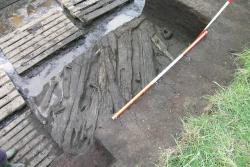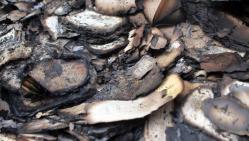21 DECEMBRE
INDI-UNI : ANTHROPOLOGY - ARCHAEOLOGY
INSCRIPTION 2012 COURS A DISTANCE
REGISTRATION 2012 ONLINE COURSES
SUEDE –  Stockholm - Les épaves de cinq navires datant du XVIe au XVIIIe siècle ont été découvertes dans le centre de Stockholm. La nouvelle a été annoncée lundi le Musée maritime suédois. Ces bateaux, dont certains sont longs d’une vingtaine de mètres, «sont en bon état». Cette découverte a été faite lors de la rénovation du quai de Strömkajen, situé sur la mer Baltique. Elle «apporte un éclairage sur le chantier naval où a été construit le navire de guerre royal Vasa et sur diverses périodes de l’histoire de la ville.» Selon l’archéologue du musée, Andreas Olsson, «les découvertes qui comprennent des outils et des ustensiles à usage domestique, révèlent comment la population vivait à Stockholm au XVIe et au début du XVIIe siècle». La Suède a célébré cette année le 50e anniversaire du renflouement du Vasa, joyau de la flotte de guerre suédoise qui avait sombré dans le port de la cité, juste après avoir entrepris son voyage inaugural en 1628. Il est désormais exposé au Musée Vasa de Stockholm qui constitue la plus importante attraction touristique du pays scandinave. Ces découvertes suivent de bien peu celles de deux navires très importants en mer Baltique. Il s’agit du Mars et du Sabre, dont les retrouvailles ont été annoncées en novembre 2011. Il s’agit là de vaisseaux énormes. Il y avait plus de 800 hommages d’équipage à bord du Mars, coulé en 1564 au cours d’une bataille navale. Il s’en trouvait 650 dans le Sabre, sabordé en 1576. Une fois renflouées, toutes ces épaves pourront rejoindre celles du Vasa, et du Marie Rose, coulé en 1545 et sorti de l’eau en 1982.
Stockholm - Les épaves de cinq navires datant du XVIe au XVIIIe siècle ont été découvertes dans le centre de Stockholm. La nouvelle a été annoncée lundi le Musée maritime suédois. Ces bateaux, dont certains sont longs d’une vingtaine de mètres, «sont en bon état». Cette découverte a été faite lors de la rénovation du quai de Strömkajen, situé sur la mer Baltique. Elle «apporte un éclairage sur le chantier naval où a été construit le navire de guerre royal Vasa et sur diverses périodes de l’histoire de la ville.» Selon l’archéologue du musée, Andreas Olsson, «les découvertes qui comprennent des outils et des ustensiles à usage domestique, révèlent comment la population vivait à Stockholm au XVIe et au début du XVIIe siècle». La Suède a célébré cette année le 50e anniversaire du renflouement du Vasa, joyau de la flotte de guerre suédoise qui avait sombré dans le port de la cité, juste après avoir entrepris son voyage inaugural en 1628. Il est désormais exposé au Musée Vasa de Stockholm qui constitue la plus importante attraction touristique du pays scandinave. Ces découvertes suivent de bien peu celles de deux navires très importants en mer Baltique. Il s’agit du Mars et du Sabre, dont les retrouvailles ont été annoncées en novembre 2011. Il s’agit là de vaisseaux énormes. Il y avait plus de 800 hommages d’équipage à bord du Mars, coulé en 1564 au cours d’une bataille navale. Il s’en trouvait 650 dans le Sabre, sabordé en 1576. Une fois renflouées, toutes ces épaves pourront rejoindre celles du Vasa, et du Marie Rose, coulé en 1545 et sorti de l’eau en 1982.
http://www.tdg.ch/actu/culture/epaves-historiques-decouvertes-plein-stockholm-2011-12-20
ABU DHABI - While Shaikh Diab Bin Eisa is acknowledged as the first leader to encourage his tribe members to form permanent settlements on Abu Dhabi Island once fresh water was discovered in 1761, increasing archeological discoveries have revealed evidence of human settlement as far back as the Stone Age. "There is evidence that proves that the Al Ain area has been occupied consistently for at least 6,000 to 7,000 years… based on discoveries of the Hafeet Tombs to ADACH's [Abu Dhabi Authority for Culture and Heritage] latest discovery on Dalma Island and Al Khan in Sharjah," Peter Hellyer, Director of Research at the National Media Council, said. The Hafeet Tombs, located at the bottom of Jebel Hafeet, are dated between 3200BC and 2700BC. A group from the UK's Southampton University uncovered neolithic, medieval and later structures on Dalma Island. Since the 1950s, archeological teams from around the world have visited the Abu Dhabi to begin the process of uncovering the emirate's past. This has led to the discovery of archeological sites that date back to 150,000 years ago, to disk-shaped tools made from local flint in the Western Region, which were dated at approximately 7,500 years ago, and evidence of settlements at Umm Al Nar island during the Bronze Age, among other sites.
http://gulfnews.com/news/gulf/uae/heritage-culture/settlements-in-abu-dhabi-island-date-back-to-the-stone-age-1.954637
ROYAUME UNI –  Star Carr - On the advice of English Heritage, the early Mesolithic site at Star Carr, North Yorkshire is being made a scheduled monument for its rarity and archaeological importance. The designation provides legal protection for the site where last year a team of archaeologists, from York and the University of Manchester, discovered Britain's earliest surviving house. The house dates to at least 9,000 BC - when Britain was part of continental Europe. The research team unearthed the 3.5 metres circular structure next to an ancient lake at the site, near Scarborough, which archaeologists say is comparable in importance to Stonehenge. They also excavated a well preserved 11,000 year-old tree trunk with its bark still intact and the earliest evidence of carpentry in Europe. Star Carr is an early Mesolithic occupation site near Scarborough, North Yorkshire and is an exceptionally rare site due to its remarkable survival of organic material from this prehistoric date and the evidence of built structures on the site. It is known for the great diversity of finds and archaeological features from the site. Some of these are visually spectacular such as the head-dresses now in the British Museum, while some, such as worked timbers, demonstrate the early use of stone tools for carpentry.
Star Carr - On the advice of English Heritage, the early Mesolithic site at Star Carr, North Yorkshire is being made a scheduled monument for its rarity and archaeological importance. The designation provides legal protection for the site where last year a team of archaeologists, from York and the University of Manchester, discovered Britain's earliest surviving house. The house dates to at least 9,000 BC - when Britain was part of continental Europe. The research team unearthed the 3.5 metres circular structure next to an ancient lake at the site, near Scarborough, which archaeologists say is comparable in importance to Stonehenge. They also excavated a well preserved 11,000 year-old tree trunk with its bark still intact and the earliest evidence of carpentry in Europe. Star Carr is an early Mesolithic occupation site near Scarborough, North Yorkshire and is an exceptionally rare site due to its remarkable survival of organic material from this prehistoric date and the evidence of built structures on the site. It is known for the great diversity of finds and archaeological features from the site. Some of these are visually spectacular such as the head-dresses now in the British Museum, while some, such as worked timbers, demonstrate the early use of stone tools for carpentry.
http://www.artdaily.org/index.asp?int_sec=11&int_new=52529
USA – Portwalk - Developers of Portwalk on Tuesday released results of an archaeological sensitivity assessment for the final phase of the major downtown project. The study, conducted by Independent Archaeological Consulting LLC of Portsmouth, covers the background and historical significance of the parcel at 195 Hanover St. The 13-page report includes schematics, site maps and a listing of reference material. It also includes a slate of recommendations and conclusions. The assessment identifies three areas where archeological resources are likely to be present. The first is the northeast corner of Portwalk Lot 3 at the intersection of Deer and Vaughan streets, the former homestead of merchant Titus Salter, according to the report. The area was minimally affected by development over the years. "We anticipate that the back yard will contain deposits related to the Salter occupation and that its household privy might be present," the report states. The next area is the intersection of Deer Street and Maplewood Avenue, a site once was home to Phoebe Hart. The house is believed to have stood there from the early 1800s to urban renewal of the 1970s. Area 3 is considered to be the non contiguous extension of the Hart house lot, which may contain resources from at least one privy and elements from a blacksmith shop.
http://www.seacoastonline.com/apps/pbcs.dll/article?AID=/20111221/NEWS/112210360/-1/NEWSMAP
ROYAUME UNI - Standing at seven feet seven inches tall (2.3 metres), Byrne was a celebrity in his own lifetime and when he died in 1783 at the age of 22, the renowned surgeon and anatomist John Hunter was keen to acquire his skeleton. According to the British Medical Journal (BMJ), Byrne was terrified of becoming one of Hunter's specimens and wanted to be buried at sea. But the surgeon managed to bribe one of the Irishman's friends and took his body before it could be laid to rest in the English Channel. Hunter boiled Byrne's body down to a skeleton and it became a key feature of his anatomy collection. This was later displayed at the Hunterian Museum at the Royal College of Surgeons in London, where it remains today. In the BMJ article, experts acknowledge the role the skeleton has played in research, including by helping to link acromegaly -- an unusual condition where someone produces too much growth hormone -- and the pituitary gland. But Len Doyal, emeritus professor of medical ethics at Queen Mary university in London, and Thomas Muinzer, a lawyer at Queen's University Belfast, say it is now time to grant Byrne's wish and give him a peaceful burial at sea.
http://www.physorg.com/news/2011-12-experts-urge-18th-century-irish-giant.html
EGYPTE –  Le Caire - Volunteers in white lab coats, surgical gloves and masks were standing on the back of a pickup truck along the banks of the Nile River in Cairo, rummaging through stacks of rare 200-year-old manuscripts that were little more than charcoal debris. The volunteers, ranging from academic experts to appalled citizens, have spent the past two days trying to salvage what’s left of some 192,000 books, journals and writings, casualties of Egypt’s latest bout of violence. Institute d’Egypte, a research center set up by Napoleon Bonaparte during France’s invasion in the late 18th century, caught fire during clashes between protesters and Egypt’s military over the weekend. It was home to a treasure trove of writings, most notably the handwritten 24-volume Description de l’Egypte, which began during the 1798-1801 French occupation. The compilation, which includes 20 years of observations by more than 150 French scholars and scientists, was one of the most comprehensive descriptions of Egypt’s monuments, its ancient civilization and contemporary life at the time. The Description of Egypt is likely burned beyond repair. Its home, the two-story historic institute near Tahrir Square, is now in danger of collapsing after the roof caved in.
Le Caire - Volunteers in white lab coats, surgical gloves and masks were standing on the back of a pickup truck along the banks of the Nile River in Cairo, rummaging through stacks of rare 200-year-old manuscripts that were little more than charcoal debris. The volunteers, ranging from academic experts to appalled citizens, have spent the past two days trying to salvage what’s left of some 192,000 books, journals and writings, casualties of Egypt’s latest bout of violence. Institute d’Egypte, a research center set up by Napoleon Bonaparte during France’s invasion in the late 18th century, caught fire during clashes between protesters and Egypt’s military over the weekend. It was home to a treasure trove of writings, most notably the handwritten 24-volume Description de l’Egypte, which began during the 1798-1801 French occupation. The compilation, which includes 20 years of observations by more than 150 French scholars and scientists, was one of the most comprehensive descriptions of Egypt’s monuments, its ancient civilization and contemporary life at the time. The Description of Egypt is likely burned beyond repair. Its home, the two-story historic institute near Tahrir Square, is now in danger of collapsing after the roof caved in.
http://arabnews.com/middleeast/article550955.ece